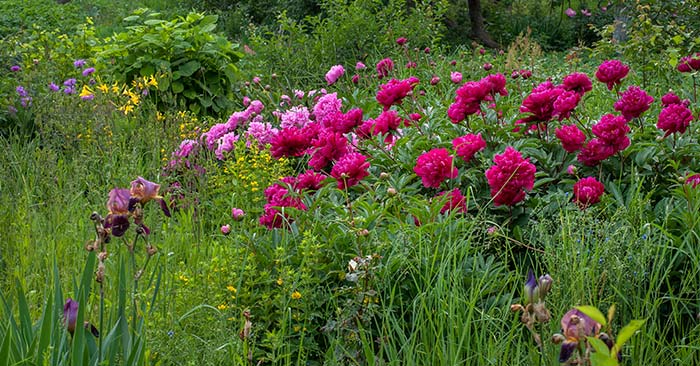How to Successfully Overwinter Peonies in Pots
To successfully overwinter peonies in pots, ensure the pots have good drainage and insulate them with mulch or bubble wrap. Please place them in a sheltered location and water sparingly to maintain soil moisture and protect them from extreme temperatures.
Curious about how to keep your peonies blooming year after year despite harsh winters? Discover the secrets to successfully overwintering peonies in pots with simple, effective techniques to ensure your garden is the envy of the neighborhood come spring. Keep reading to unlock the complete guide!
Choosing the Right Spot and Location
Before winter sets in, it’s crucial to ensure your pots are prepared for the cold months ahead. Here’s how you can do it:
- Select Appropriate Containers: Use large pots with suitable drainage holes. This is vital because peony roots are susceptible to waterlogging, which can cause rot during the winter.
- Insulate Your Pots: To protect the roots from freezing temperatures, consider wrapping the pots with insulating materials such as bubble wrap or burlap.
- Sheltered Location: Move the pots to a sheltered area, like a garage or covered patio. This helps shield them from harsh winds, heavy rain, and drastic temperature fluctuations. If you don’t have a garage, placing them against a south-facing wall can provide some protection.

Image Source: Envato Elements
Mulching for Warmth
Mulching is an effective way to insulate your peonies against the cold. Here’s how I do it:
- End of Growing Season: Once the growing season concludes and the foliage has died back, spread a thick layer of mulch over the soil surface in the pot.
- Types of Mulch: You can use straw, leaves, or wood chips. I prefer straw as it provides excellent insulation.
- Benefits: This layer of mulch helps regulate soil temperature and prevents the roots from freezing. It also helps retain soil moisture during the winter.
Watering and Hydration
Even though peonies in pots need less water during the winter, it’s essential to maintain proper hydration levels:
- Pre-Winter Watering: Water your peonies thoroughly before the first frost. This ensures they are well-hydrated going into the dormant season.
- Regular Checks: Check the soil moisture periodically throughout the winter. If the soil feels dry, give it a light watering. However, avoid overwatering as this can lead to root rot.
Pruning and Spring Transition
As winter comes to an end and temperatures start to rise, it’s time to prepare your peonies for their spring revival:
- Remove Mulch: Gradually remove the mulch from the soil surface once the danger of frost has passed. This allows the soil to warm up and encourages new growth.
- Pruning: Cut back dead or damaged stems to promote healthy new growth.
- Transitioning to Sunlight: Start by moving the pots to a partially shaded area to acclimate the plants to the increased light levels. Over a week or two, gradually transition them to a location with full sun.
Troubleshooting Common Issues
Even with the best care, you might need some help. Here are a few common issues and how to address them:
- Frost Damage: If late frost is a concern, consider keeping frost blankets on hand to cover the pots during unexpected cold snaps.
- Root Rot: Ensure the pots have adequate drainage and avoid waterlogging the soil.
- Pests: Check for pests such as aphids or spider mites while overwintering indoors. Treat them with appropriate insecticidal soap if necessary.
FAQs on How to Successfully Overwinter Peonies in Pots
Q: Can I leave my peonies outside all winter?
A: While it’s possible, it’s not recommended if you live in an area with harsh winters. The best practice to ensure their survival is to move them to a sheltered location or provide extra insulation.
Q: How much should I water my peonies during the winter?
A: Watering needs are minimal during the winter, but the soil should not be arid. Water lightly if the soil feels dry to the touch.
Q: What type of mulch is best for peonies?
A: Straw, leaves, and wood chips are all good options. Straw is often preferred for its excellent insulating properties.
Adding Value with Personal Insights
From my experience, overwintering peonies in pots can be a rewarding process if done with care. When I see the first shoots emerging each spring, it reminds me of the importance of preparing them well for winter.
Over the years, I’ve learned that attention to detail, especially insulation and hydration, significantly affects their health and bloom quality.
Conclusion
With the proper preparation and care, successfully overwintering peonies in pots is achievable. By choosing suitable containers, insulating properly, and maintaining adequate moisture levels, you can ensure your peonies thrive year after year.
Remember, the key is to protect them from extreme conditions while keeping them hydrated and healthy.
Seasonal Care Tips for Peonies in Pots
To keep your potted peonies healthy throughout the year, here are some seasonal care tips to follow:
Spring
- Fertilizing: Once the peonies start showing new growth, apply a balanced fertilizer to support their development. I usually use a slow-release granular fertilizer.
- Watering: Increase watering frequency as the weather warms up, ensuring the soil remains moist but not waterlogged.
- Support Structures: As peonies grow, their blooms can become quite heavy. Installing support structures, like stakes or peony rings, helps prevent the stems from bending or breaking.
Summer
- Deadheading: Remove spent blooms to encourage more flowers and prevent the plant from using energy to produce seeds.
- Pest Control: Watch for common pests like aphids and apply appropriate treatments if necessary.
- Water Management: During hot spells, ensure your peonies receive adequate water. Potted plants can dry out more quickly than those in the ground.
FAQs on How to Successfully Overwinter Peonies in Pots
- Pruning: After the first frost, prune the peonies to a few inches above the soil. This helps prepare them for the dormant period.
- Soil Care: Add compost or organic matter to refresh the soil and provide nutrients for the next growing season.
- Preparation for Winter: Follow the earlier steps to insulate and protect your peonies from overwintering.
Common Challenges and Solutions
Despite your best efforts, you may need help with overwintering peonies in pots. Here’s how to address them:
- Waterlogging: Ensure proper drainage by checking that the pot’s drainage holes are not blocked. Elevating the pots on pot feet can help improve airflow and drainage.
- Cold Damage: If you notice frost damage, it might be due to insufficient insulation. Consider adding an extra layer of mulch or using a frost blanket during freezing periods.
- Nutrient Deficiency: Yellowing leaves can indicate a lack of nutrients. A balanced liquid fertilizer can quickly address this issue, but be careful not to over-fertilize, especially during dormancy.
My Personal Experience with Overwintering Peonies
I started growing peonies in pots a few years ago and have learned much through trial and error. One winter, I forgot to check the soil moisture regularly, and some of my peonies suffered from dry roots. Since then, I make it a point to check the soil at least once a week during winter.
I also experimented with different types of mulch. While straw worked best for me, I found that leaves can sometimes harbor pests, so monitoring the mulch layer and replacing it if necessary is essential.
How to Identify and Handle Dormancy Issues
Peonies undergo a natural dormancy period during winter, but it’s essential to recognize if there are any issues:
- Delayed Sprouting: If your peonies are slow to sprout in the spring, it could be due to insufficient chilling hours. Ensure your plants experience enough cold to break dormancy.
- Weak Growth: Stunted growth in spring might indicate root damage. Gently check the roots for any signs of rot or damage and trim away affected areas.
- Leaf Discoloration: Yellowing or browning leaves in spring can indicate nutrient deficiency or water stress. Adjust your care routine accordingly.
Transitioning from Pots to Garden
If you decide to transplant your peonies from pots to your garden, here’s how to do it successfully:
- Timing: The best time to transplant peonies is in the fall after they have finished blooming and the foliage has died back.
- Site Selection: Choose a location with well-draining soil and total sun exposure. Peonies thrive in areas where they receive at least six hours of sunlight daily.
- Transplanting Process: Dig a hole slightly larger than the pot. Gently remove the peony from the pot, careful not to damage the roots. Please place it in the hole, backfill it with soil, and thoroughly water it.


